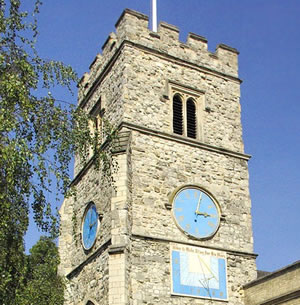Bells to Ring Out in Putney for World War One Hero
George Honeyball to be remembered 100 years to the day after his death at Ypres
Church bells in Putney are to be rung to commemorate a bell ringer from a local Church who gave his life in the first world war.
On 16 August the bells of St. Mary’s Church will sound for George Honeyball who research has shown served as a ringer there before being presumed killed in action on August 16th 1917 during the Third Battle of Ypres at the Battle of Langemarck. His body was never identified so he is commemorated on the Tyne Cot memorial at West-Vlaanderen, close to where he fell in battle.

The belltower of St. Mary's Church
The 1891 census shows that George and his family were living in Putney, at 10 Upper Park Fields (now renamed Coalecroft Road) with his father William, who was also a bell ringer at St. Mary’s, is described as a gardener/domestic servant and his mother Emma, and George is aged 7. By the time of the 1901 census George is described as a coal order clerk.
On 8 April 1912 George rang a full peal - 5040 changes of "Grandsire Triples" at St Mary's Putney along with his father and Thomas Bolton, the tower captain, well known Putney figure and local chimney sweep and coalman, quite possibly George’s employer. This was the first peal rung at the tower by an all-local band though many other peals had been rung there previously, the bells having become a peal of eight at the rebuilding of the church in 1836. A very similar band, again including both Honeyballs and Bolton rang another “local” peal on 14 April 1914.
George signed up with the East Surreys which were part of Kitchener’s New Armies and later, after he landed in France was transferred to the Royal Inniskilling Fusiliers. His medical assessment from 1917 survives which shows that he was 5 foot 4 inches tall, with a 35 inch chest and was currently residing at 148 Putney Bridge Road.
On the centenary of his death, George will be remembered during the usual 12.30pm Eucharist at St Mary’s. At its conclusion, Alan Regin will give a short talk about the project generally to remember ringers in this way, about George Honeyball in particular and about the Ypres Bells project. There will be some displays in the church for visitors to examine and local historian, Mike Bull, will be on hand to explain their significance and also the significance of the full peal of “Yorkshire Surprise Major” which will be rung on St Mary’s bells during the afternoon. Local ringers, including David Underdown, will be joined by Alan and Ian for this historic performance which will be conducted by Christopher Mew of Warwick, himself a former Ringing Master of St Mary’s where he was a member of the band from 1957-1973 and who has recently retired following a 3-year term as President of the Central Council of Church Bellringers.
The idea for remembrances such as this one came about in 2014, as the centenary of the outbreak of WW1 approached, people were asked to arrange their own local commemorations in addition to those being organised nationally. Following a suggestion originating from the Central Council of Church Bell Ringers, ringers up and down the country, and overseas, are remembering fellow ringers who gave their lives during the conflict by ringing the bells at churches where they were members of the local team or “band” on the 100th anniversary of their deaths.
Local bands are being assisted in this by Alan Regin, the Steward of the Central Council’s "Rolls of Honour" of ringers killed on active service. These confirm dates and church towers to which the deceased were attached and are housed at St Paul's Cathedral. The records enable Alan to alert local churches when a centenary anniversary is approaching.
George Honeyball appears on this Roll of Honour at St Paul’s Cathedral and he is also commemorated within St Mary’s, Putney War Memorial; at the Richardson Evans Memorial Playing Fields, Wimbledon Common; and on the war memorial at Aldham in Essex which was his original family home.
The Central Council is encouraging as many peals as possible to be rung on those anniversaries to honour those who died, to promote local interest in their stories and, it is hoped, to promote interest in the art of ringing. A “peal” may be either a short ring, a “Quarter Peal” which is about 45 to 50 minutes ringing or a “full peal” of 5000 or more changes which can take anything between two and a half and four hours to ring depending on the weight and number of the bells being rung.
Alan has spent many hours researching these stories assisted by David Underdown, himself a ringer at St Mary's, Putney. David works at the National Archive and has access to much of the information. Each month Alan publishes an article in the “Ringing World” – the bellringers’ weekly newspaper – telling the stories of those whose centenaries occur in that particular month. Sometimes more than one such article is needed.
Alan and Ian Campbell, who rings at St Paul's Cathedral but is also a regular supporter of ringing at St Mary's are Trustees of a Fund to have a peal of 8 bells to be rung “English” style installed in the Anglican church at Ypres later this year.
July 21, 2017
Related links
|